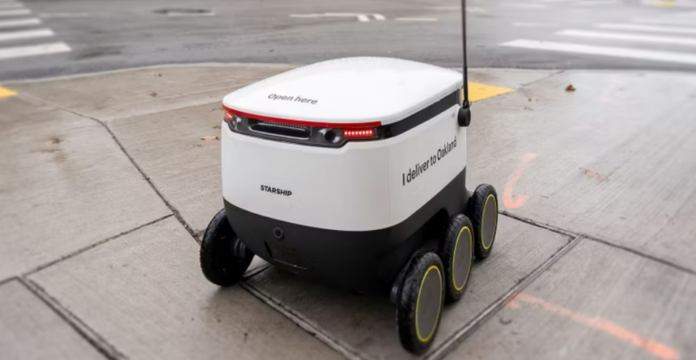Pretty soon, robots may be delivering food and packages straight to your door. Here’s how they work and what you need to know.
A distant future involving robotic package deliveries is now very much a reality. Advances in robotics, GPS tracking, automation, and navigation now mean you might not find a delivery person at your door with your package. You might find a delivery robot instead.
A delivery robot is an automated robot that brings your delivery directly to your door. These robots aren’t walking and talking humanoids; rather, these robots are cute delivery containers on six wheels, resembling giant (but friendly-looking!) bugs.
As with other delivery services, you make your purchases through an app with vendors based on your location. The robot trundles to the vendor—whether for shopping, food, drinks, or otherwise—and then it makes its way to your home.
How Does a Delivery Robot Work?
The primary example of delivery robots in action comes from Starship Technologies, a company based out of San Francisco with engineering facilities in Estonia and Finland. Starship Technologies is the brainchild of Skype co-founders Janus Friis and Anti Heinla, and they are currently the largest “last mile” delivery robot company around.
How Do Delivery Robots Navigate?
The route between a vendor and a delivery point might look A-to-B if you plug the locations into a navigation app… but there are extra considerations for a delivery robot, including sidewalks, crossings, driveways, humans, animals, vehicles, and so on.
Starship’s robots calculate a route based upon the shortest distance and satellite imagery detailing the route. Each feature on the route (crossings, driveways, etc.) receives a time calculation, which the robot factors into route selection and delivery time.
Over time, the robots build a collaborative memory of an area, creating a wireframe map of constant features (buildings, crossings, statues, pathways, etc.) and ensuring that future journeys through the area are faster. The collaborative area-building makes navigation easier for every robot in the vicinity, with all units contributing to building out the local map.
But navigation isn’t always smooth sailing. Aside from regular navigational dilemmas, a malfunctioning robot comes with its own problems. For example, a Starship robot in Milton Keynes malfunctioned—and drove straight into a canal.
Does Anyone Control the Delivery Robot?
While the Starship Technology robots are autonomous, they are not disconnected from their operators. If a robot comes up against a significant challenge, such as a particularly massive curb (they can climb up and over regular sidewalk curbs), a human operator can take control and find a solution.
But for the most part, the robots are designed to take everything into account, focusing strongly on the sidewalk. Delivery robots sharing the same routes as pedestrians has all the potential for irritation.
All these potential issues are all considered, but the robots must learn the correct way to interact with humans. How many times have you faced the awkward situation of walking at a similar pace to someone just ahead of you? Do you speed up to pass, then continue walking faster? Do you slow down to give them time to move further ahead? Is your destination close enough so that you don’t need to overtake?
The delivery robots are learning how to solve these problems, as well as countless others.
Delivery Robots and COVID-19
The 2020 COVID-19 pandemic provided a new and interesting dynamic for Starship Technologies and its delivery robots. With huge numbers of people entering lockdown at differing times and with many people attempting to self-isolate and socially distance from the general public, the delivery robots present a perfect non-human delivery system.
In Milton Keynes, UK, the demand for robot deliveries rose significantly during the early stages of the UK COVID-19 lockdown. The US cities and university campuses also saw similar demand for robotic, almost zero-human interaction deliveries. For those on at-risk lists due to pre-existing conditions or healthcare workers struggling to purchase groceries after a long shift, robotic deliveries are a vital lifeline.
Delivery Robots Are Coming to Your Home
A friendly delivery robot bringing curry to your door is charming and is a reality for millions of people. The rollout of delivery robots won’t be overnight, and there are significant challenges for the delivery robotics sector, as well as rural communities.
Analysis
Delivery robots were in discussion and development before COVID but it’s demand spiked due to covid-19 and the situations revolving social distancing and staying at home. However, unironically they have become a familiar face in school campuses and much more and although they may be sometimes in the way, they are fun to see roaming around campus, working. When they first arrived at OSU campus, many of the students were very intrigued by a new companion on campus. At time they may be a bit too slow but at times they are a fun face to see when walking around campus, getting stuck between students during rush hours. But not only can they divide up a delivery task, but in the long run, more inexpensive for users. They have a system that runs very well in locations like schools and certain cities. Although they aren’t perfect, they definitely have a place to be and will continue to develop and may have more a presence in our day to day life in the future.




